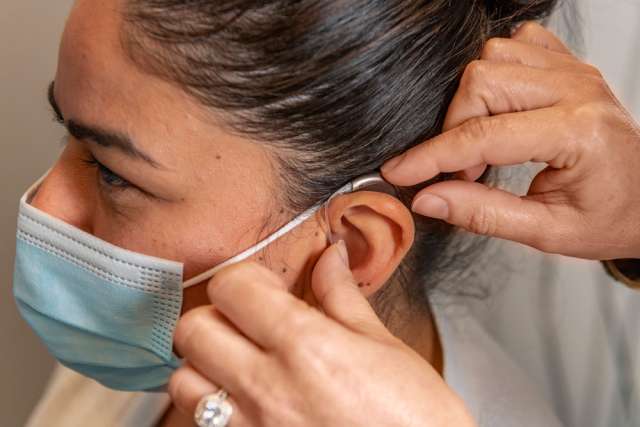Hearing aids used to be cumbersome and uncomfortable to wear, but advances in technology have led to development of devices that today are smaller, more sophisticated and easier to use. Yet, only about 10-to-15% of people who could benefit from hearing aids actually have them, UCLA experts say.
“People with untreated hearing loss are more likely to become socially isolated, depressed,” says Alison M. Grimes, AuD, director of audiology and newborn hearing screening at UCLA Health. “It is best not to ignore hearing loss.”
To address this issue, UCLA Health has opened a retail clinic on Westwood Boulevard, near its medical plaza in Westwood, where consumers can walk in for information or make appointments for counseling, hearing tests, hearing-aid fittings and follow-up visits.
Pending legislation in Congress may make access to hearing aids even more widely available for many people who up to now may have been deterred by the cost. The proposed legislation would expand Medicare coverage to include hearing-care needs. The federal government also has proposed a new class of hearing aids, labeled over-the-counter, that would shift hearing aids away from a medical classification to more of a consumer product model, Dr. Grimes says.
Even today’s basic digital hearing aids offer far more benefit than the best hearing aids of previous generations.
While the technolog y has advanced significantly, the basic components of a hearing aid remain essentially unchanged: a microphone, a processor, a receiver and a power source. The differences lie primarily in the sophistication of the processor, which filters and amplifies sound. Even today’s basic digital hearing aids offer far more benefit than the best hearing aids of previous generations. “There are hearing aids that range from verylow-end amplifiers to extremely high-end devices that are programmed and managed by an audiologist. We will have a wide range of options and price points for all patients,” says Ellen Wilson, executive director of therapy services at UCLA Health. “The difference we offer is that our hearing aids are fitted by an audiologist and not a technician at a big-box store.”
The retail clinic provides the same high-quality care that is offered in a medical setting, Wilson says, with trained and highly experienced professionals who work with consumers to find the best solution for an individual’s lifestyle and budget. An initial 30-minute informational consultation for adults is provided at no charge.
In addition, the storefront’s staff has access to UCLA Health physicians to assist with more complex cases. “We collaborate with the head and neck physicians,” Wilson says. “We look at these issues through a medical lens. If the hearing loss turns out to be something more serious, we can catch that during the hearing exam.”
The technological innovations available in today’s devices may surprise some consumers. For example, many hearing aids are Bluetooth compatible, enabling them to wirelessly connect to a smartphone, improving sound quality and eliminating potential feedback from a microphone. Some higher-end devices even have artificial intelligence, which enables them to learn the optimal settings for different sound environments. And most come with smartphone apps that allow users to make adjustments, contact their hearing-care specialist and monitor battery life. Some also can route phone calls or other sources of sound directly to the user’s hearing aid.
“The difference we offer is that our hearing aids are fitted by an audiologist and not a technician at a big-box store.”
“Hearing aids have a lways been a n important tool in health care,” Dr. Grimes notes. “Today’s hearing aids — smaller, sleeker, more discreet — have come a long way from when they were designed to simply make all sounds louder. Now, they have the technology to help the user sort out intelligible speech from interfering noises. For someone who is having difficulty hearing, finding the correct aid can significantly improve their quality of life.”
